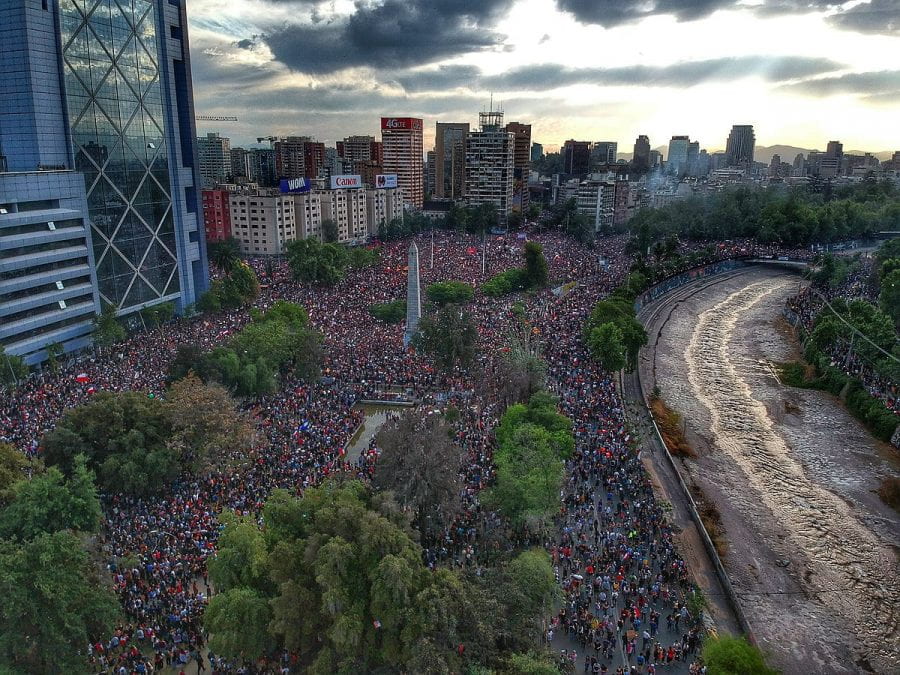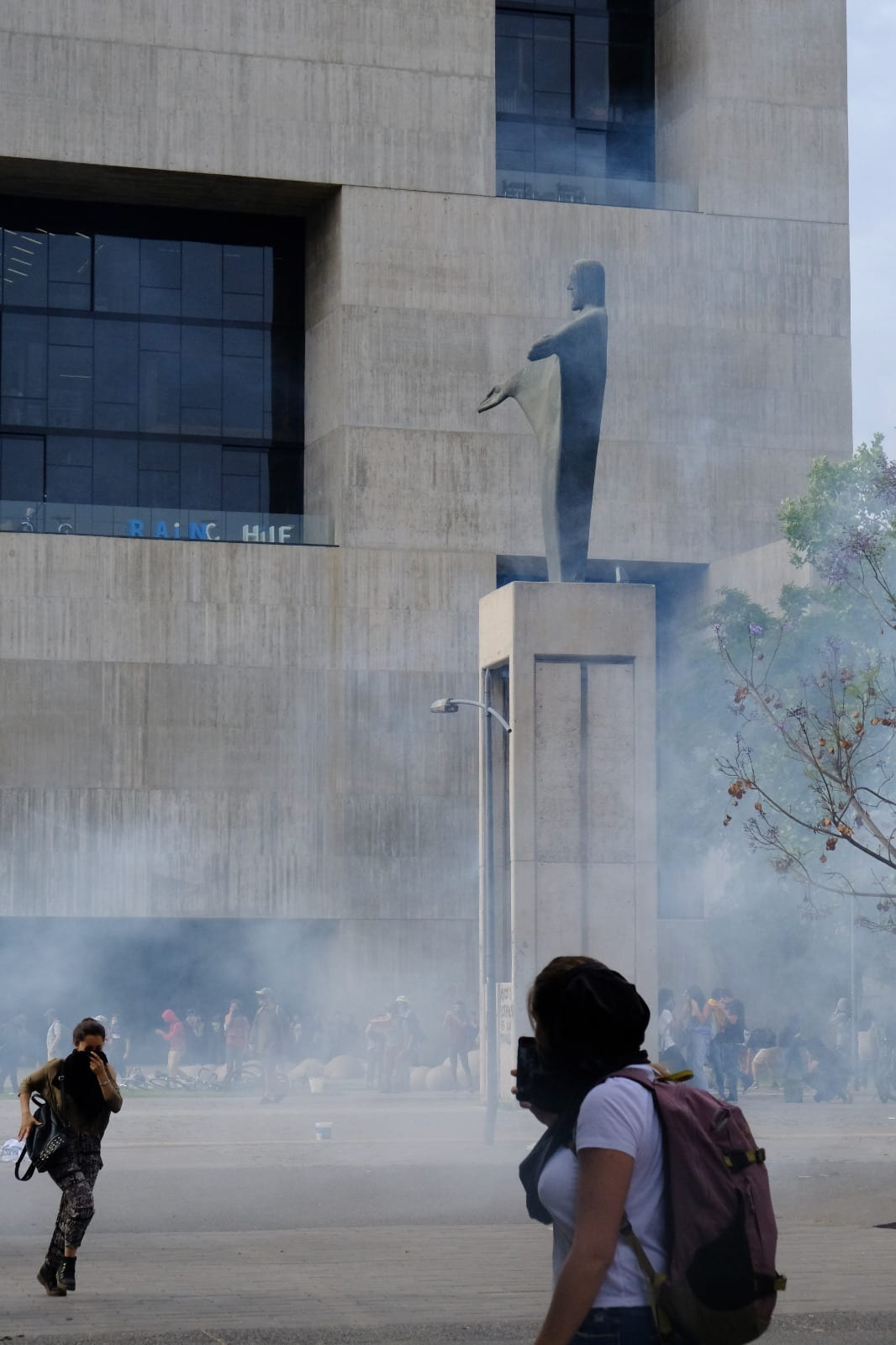“I can feel the joy of the group”: a conversation with a veteran journalist on the largest march in Chile
By Alfonso Otaegui, on 18 November 2019
Massive demonstrations in Chile
Since the 18th of October, Chile has been in continuous turmoil. Protests that initially began as a response to a rise in metro fares in Santiago escalated into a national crisis, laying bare the tensions that had hitherto been contained in Chilean society. The surface calm that dominated the so-called “paradise of Latin America” was proven to be very fragile.
At the moment of writing, and since the 18th of October, there have been daily marches and demonstrations, with barricades and looting but also brutal repressions and curfews. Protester demands include pay rises for workers, education reform, changes to pensions and investment in the state health system among others. In recent weeks, these grievances have crystallised into an overriding demand: a new constitution to replace the one sanctioned by the government of dictator Augusto Pinochet in 1980.
Having lived here since January 2018, and in neighbouring Argentina almost all my life, I, like many, was utterly bewildered at the scale of the outbreak. Chile isn’t a country famous for protests and mass demonstrations. During the first days of the protest, I received a WhatsApp message from Valeria, a former student in the smartphone workshops for older adults that I taught as a volunteer during my fieldwork. The message was a photo of her celebrating her 81st birthday by participating in one of the ‘largest marches in Chile’ with a friend. This was a march to Italia Square, renamed by the protesters “Dignity Square” (a change that even appeared on Google Maps for a brief amount of time). Curious about her perspective on the mobilisation of protesters and the current situation in the country, I asked her to meet. Valeria had to flee the country as soon as the coup happened in 1973 because her name was included on a list of left-leaning journalists affiliated to a political party that was in the opposition, meaning she could be searched by the police at any time. After living in the UK for 20 years, she returned to Chile in the early 1990s.
Valeria agreed to meet me and I made my way to her apartment, near the Plaza de Armas (Santiago’s main square). As I arrived to meet Valeria near her home, I noticed several stores were closed – too many for a Saturday afternoon – most of them secured with metal curtains.
“It looks like a post-war zone,” says Valeria, welcoming me in her apartment on the 13th floor. She tells me that a few weeks before, she was left without a functional lift for a whole weekend. When taking the stairs on her way out of the building she fell over, which caused her head wounds that needed stitches.
“It was a huge blow, but I did not break any bones!” –she says with relief, almost cheerful.
As she makes me tea, I observe the souvenirs adorning her living room: black and white photos of her childhood in Valdivia, photos from her years in Santiago, an old map of South America, a windmill with the Mapuche flag in a plant pot, a piece of macramé with the figure of a winged dragon (a souvenir of her exile years in Wales), and on a glass coffee table some tea boxes, porcelain cups, a half-read book and a TV remote control.
Conversing with a veteran journalist about the news
Valeria inherited this apartment from her family, and receives monthly compensation granted to former political refugees. The allowance is more or less equivalent to the lowest state pension in the country and is not enough to live on, as is the case for so many other older adults in Chile. Valeria manages to make ends meet because she does not pay rent and has a small inheritance from her parents which she manages very carefully.
Valeria brings me tea. On the table, at arm’s length, she has her smartphone. As a journalist, she is fascinated by what the device offers when it comes to information and communication. Valeria was always the one sharing videos, memes, information about free events and the occasional political opinion in the WhatsApp group chat of former students of the workshop. The members of the group chat had always had subtle differences of opinion on political issues, but in recent weeks those differences became frictions, reflecting the polarised nature of the current discourse in Chile, which is visible on all of the most popular social networks in the country. A participant decided to leave the group and the frequency of messages declined (Valeria’s in particular). Although her opinions may not be representative of the Chilean older adult population, they are shared by quite a few people.
“Fake news is the order of the day” warns the veteran journalist as she digs up news items distributed among her numerous WhatsApp groups. Valeria does not trust local TV news, preferring to receive information from trusted journalist contacts through Whatsapp, making the assumption that they wouldn’t pass on a news item without verifying the information in it first.
Valeria is careful not to draw any parallels between different eras, and on more than one occasion she emphasises that she did not experience the Pinochet dictatorship (having had to leave the country as soon as it started), but the conversation alternates between old memories and the events of the past few days. She remembers a ‘guanacazo’ (a hit from the water cannon, nicknamed ‘guanaco’) she suffered almost fifty years ago –at that time the water cannon was filled with dirty water from the Mapocho river– and recalls in particular the care received from her companions, the feeling of the group being close by.
At present, Valeria also experiences the feeling of being cared for, being protected during the marches. “These boys at all times surrounded us to protect us from the [tear gas] bombs with their bottles of water, they guided us –because you are blinded by the pain– to protected areas.”
Indeed, when the police shoots tear gas into the crowds, many protesters raise their hands offering their companions bottles filled with water and baking soda, a solution that counteracts the burning sensation caused by teargas.
What astonished Valeria about this year’s protests however, is the the diversity of demands coupled with almost non-existent party identification – in the 70s, she recalls, political parties and trade unions were the ones who called the marches:
“(…) and us, university students would join them. The flags were the official ones and there was also some uniformity in the photographs. During the marches, you would hear the political slogans and shouts of the political parties. The one that was chanted by everyone was ‘the one who does not jump is a ‘momio’ and now I have heard it with the variant of ‘paco’ [derogatory for ‘police officer’]. The scarves and shirts you would see were in the official colours and patterns of the political parties, and young party members used to parade in together en masse.”
Parallels between the 1970s and now: different eras, similar feelings
The dynamics of the current marches have taken Valeria by surprise in a positive sense – now more than ever, there is a sense of joy in among all the protesting. “These young people carry our flags with a big difference: they incorporate a wonderful playful touch. We were so serious, so formal….” Valeria explains that she had never seen choreographies or dances at a march before, and couldn’t imagine something like this occuring at previous protests. This is a development that fascinates her.
The conversation swings back into the past like a pendulum. “I saw the airplanes from here,” says Valeria, pointing to the balcony. She was living in that same apartment during the coup of 73, in which the army bombed the Palacio de la Moneda, the seat of the president. Several friends called her to warn her that she had been put on a list and should stay inside. Valeria, however, devised a simple strategy to be able to walk freely through the city, despite having been declared as being ‘on the run’. She put on one of her most most elegant dresses, her best hat, golden bracelets and earrings, and carried a designer bag. “I looked like a Christmas tree!“– she says and bursts out laughing. Funnily enough, no checkpoint asked her for any documents – such an elegant woman did not fit the visual image of a dangerous citizen. “I know my country very well…”– she says, raising one eyebrow in a sardonic tone, halfway between cynicism and resignation. Maybe the strategy would still work today.
Despite parallels between anecdotes about the 1970s protests and the current day ones, we both agree that those times and these times are very different, although I can sense that Valeria is experiencing similar feelings as she did back then. It is difficult to understand what they are. The answer would come a couple of days later.
After talking for more than four hours, we said goodbye. Days later, a demonstration broke out at the San Joaquin Campus of the Catholic University where I work. The police responded to demonstrators by shooting rubber bullets and tear gas. I captured the moment and sent Valeria pictures of it through Whatsapp. One image in particular caught her eye – an image of a statue of Christ with his arms open, surrounded by tear gas smoke. Valeria replies:
“The defenseless, peaceful Christ wrapped in the gases is like an allegory. Powerful figure. My heart goes out to the students who are fighting for their parents and grandparents, and hold up their ideals as their only shield. Unequal physical struggle. The strength of these children lies in their solidarity and in their ideals of justice. They are rara avis (rare birds) among individualism and selfishness. In all the marches I have been, I feel the joy of the group.”
 Close
Close







